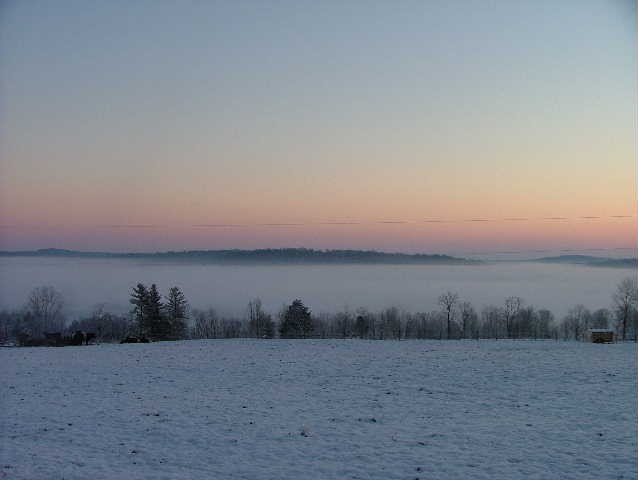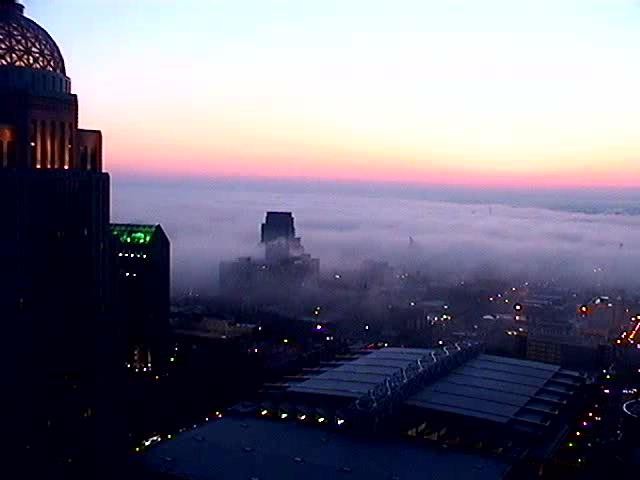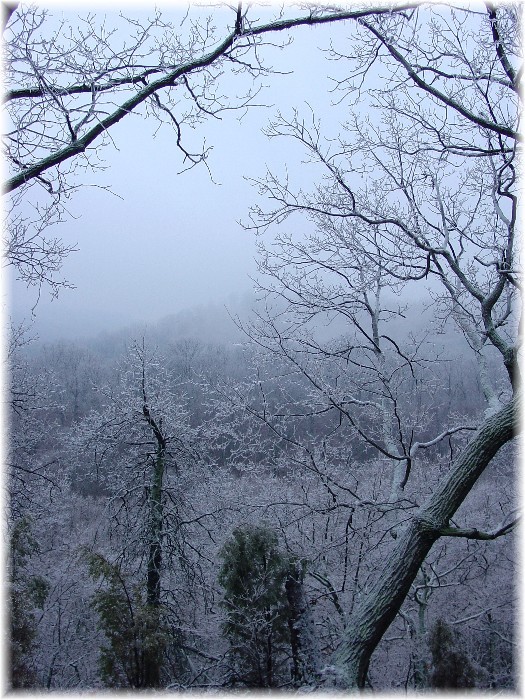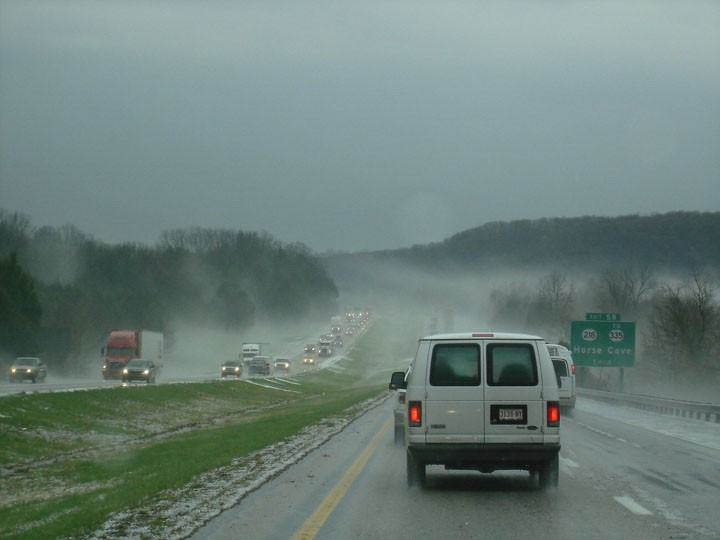Fog formation might seem like a simple weather phenomenon, but it’s actually quite complex. Fog occurs when water vapor condenses into tiny water droplets or ice crystals suspended in the air near the Earth’s surface, but how does this happen? At WHY.EDU.VN, we provide clear, expert explanations of complex topics like this. Let’s explore the different types of fog and the conditions that lead to their formation, including the science of atmospheric moisture and surface cooling, offering valuable insights into this captivating meteorological event and the weather patterns that contribute to reduced visibility.
1. What is Fog and How Does it Form?
Fog is essentially a cloud that touches the ground. It forms when the air near the Earth’s surface cools and reaches its dew point, the temperature at which air becomes saturated with water vapor. At this point, the water vapor condenses into tiny liquid water droplets or ice crystals, becoming visible as fog.
Fog formation depends on several factors:
- Moisture: There must be sufficient water vapor in the air.
- Cooling: The air temperature must decrease to reach the dew point.
- Condensation Nuclei: Tiny particles in the air (like dust, salt, or pollution) provide surfaces for water vapor to condense on.
2. What Are the Different Types of Fog?
There are several types of fog, each forming under different conditions:
2.1. Radiation Fog
Radiation fog is the most common type of fog. It forms on clear, calm nights when the Earth’s surface cools rapidly through radiation.
2.1.1. How Does Radiation Fog Form?
During the day, the Earth’s surface absorbs heat from the sun. At night, this heat radiates back into the atmosphere. On clear nights, with no clouds to trap the heat, the surface cools quickly. This cooling chills the air near the ground. If the air is moist enough, it will reach its dew point, and radiation fog will form.
2.1.2. Conditions Favoring Radiation Fog:
- Clear Skies: Allow for maximum radiative cooling.
- Calm Winds: Prevent mixing of warm air aloft with cool surface air.
- Moist Air: Provides the necessary water vapor for condensation.
- Long Nights: Provide more time for cooling.
2.1.3. Characteristics of Radiation Fog:
- Forms at night and dissipates after sunrise.
- Varies in depth from a few feet to hundreds of feet.
- Stationary, unless wind picks up.
- Can significantly reduce visibility.
2.1.4. Valley Fog: A Type of Radiation Fog
Valley fog is a specific type of radiation fog that forms in valleys. After sunset, the air on ridgetops and upper slopes cools and becomes denser. This dense air flows downhill into the valley, where it continues to cool due to radiation. As the air in the valley reaches its dew point, valley fog forms.
Valley fog can be very dense, but it typically dissipates quickly after sunrise as the sun’s energy evaporates the fog layer.
| Feature | Radiation Fog | Valley Fog |
|---|---|---|
| Formation | Radiative cooling of the ground at night | Radiative cooling in valleys, dense air drainage |
| Location | Flat, open areas | Valleys and low-lying areas |
| Dissipation | After sunrise due to solar heating | After sunrise, often rapidly |
| Density | Can vary; often moderate | Can be very dense |
| Typical Time | Late night and early morning | Late night and early morning |
| Contributing Factors | Clear skies, calm winds, moist air | Topography, clear skies, calm winds, moist air |
| Impact on Visibility | Reduced visibility, hazardous driving conditions | Severely reduced visibility in valleys |




2.2. Advection Fog
Advection fog forms when warm, moist air moves horizontally over a cold surface.
2.2.1. How Does Advection Fog Form?
When warm, moist air flows over a cold surface (like snow-covered ground or a cold body of water), the air cools from below. This cooling causes the air to reach its dew point, resulting in condensation and fog formation.
2.2.2. Conditions Favoring Advection Fog:
- Warm, Moist Air: A source of moisture is essential.
- Cold Surface: Provides the cooling necessary for condensation.
- Wind: Needed to transport the warm, moist air over the cold surface.
2.2.3. Characteristics of Advection Fog:
- Can occur day or night.
- Often widespread and persistent.
- Can be distinguished from radiation fog by its horizontal motion.
- Common in coastal areas where warm, moist air from the ocean moves over cold land.
| Feature | Radiation Fog | Advection Fog |
|---|---|---|
| Formation | Cooling of the ground at night | Warm, moist air moving over a cold surface |
| Temperature Change | Ground cools air | Air mass cools by contact |
| Time of Day | Typically at night | Can occur any time |
| Wind Conditions | Calm or very light wind | Requires wind |
| Persistence | Burns off with sunrise | Can persist for days |
| Common Locations | Inland areas | Coastal regions |
2.3. Freezing Fog
Freezing fog occurs when liquid water droplets in the fog remain in a supercooled state (below freezing) and then freeze upon contact with a surface.
2.3.1. How Does Freezing Fog Form?
In freezing fog, the water droplets are cooled below 0°C (32°F) but remain liquid due to a lack of ice nuclei (particles that promote freezing). When these supercooled droplets come into contact with a surface, they freeze instantly, coating the surface with ice.
2.3.2. Conditions Favoring Freezing Fog:
- Sub-Freezing Temperatures: Necessary to cool the water droplets below freezing.
- High Humidity: Provides the necessary moisture.
- Stable Air: Prevents mixing and allows for the formation of supercooled droplets.
2.3.3. Characteristics of Freezing Fog:
- Forms a coating of ice on surfaces.
- Can create hazardous driving and walking conditions.
- Common in high-latitude and high-altitude regions.
| Feature | Radiation Fog | Advection Fog | Freezing Fog |
|---|---|---|---|
| Formation | Ground cools air at night | Warm air over cold surface | Supercooled water droplets freeze |
| Temperature | Typically above freezing | Can be above or below freezing | Below freezing |
| Appearance | Regular fog | Regular fog | Ice coating on surfaces |
| Hazard | Reduced visibility | Reduced visibility | Icy conditions |
| Common Locations | Inland areas | Coastal areas | Cold climates |
2.4. Evaporation or Mixing Fog
Evaporation fog, also known as mixing fog, forms when water vapor is added to the air through evaporation and mixes with cooler air.
2.4.1. Steam Fog
Steam fog forms when cold air moves over warm water. The warm water evaporates, adding moisture to the air. As the moist air mixes with the cold air, it cools and reaches its dew point, causing fog to form.
2.4.1.1. Characteristics of Steam Fog:
- Looks like wisps of smoke rising off the water surface.
- Common over lakes, rivers, and hot springs in cold weather.
2.4.2. Frontal Fog
Frontal fog forms when warm raindrops evaporate into a cooler, drier layer of air near the ground. As the rain evaporates, it increases the humidity of the cool air. When the humidity reaches 100%, fog forms.
2.4.2.1. Characteristics of Frontal Fog:
- Associated with weather fronts (boundaries between air masses).
- Can be widespread and persistent.
| Feature | Steam Fog | Frontal Fog |
|---|---|---|
| Formation Process | Cold air over warm water, evaporation | Rain evaporates into cool air, increasing humidity |
| Temperature Gradient | Strong temperature difference between air and water | Temperature difference between rain and air |
| Typical Locations | Lakes, rivers, hot springs in cold weather | Near weather fronts |
| Appearance | Wisps of smoke rising from the water | Widespread, can be dense |
| Persistence | Short-lived | Can be persistent |
2.5. Hail Fog
Hail fog is a less common type of fog that forms after a heavy hailstorm.
2.5.1. How Does Hail Fog Form?
After a hailstorm, the cold hailstones cool the air near the ground. If the air is warm and moist, the cooling can cause the air to reach its dew point and form fog.
2.5.2. Characteristics of Hail Fog:
- Forms shortly after a hailstorm.
- Patchy and shallow.
- Requires light winds.
| Feature | Steam Fog | Hail Fog |
|---|---|---|
| Formation | Cold air over warm water | Air cooled by hail after a storm |
| Primary Factor | Evaporation | Cooling |
| Time Frame | Cold weather | Immediately after a hailstorm |
| Appearance | Smoke-like wisps | Patchy and shallow |
| Persistence | Relatively short-lived | Very short-lived |
3. Why is Fog Important?
Fog can have significant impacts on various aspects of life:
- Transportation: Fog reduces visibility, making driving, flying, and boating hazardous.
- Agriculture: Fog can provide moisture to crops, but it can also promote the growth of mold and fungi.
- Ecology: Fog can provide moisture to ecosystems, especially in coastal areas.
- Human Health: Fog can exacerbate respiratory problems, especially in polluted areas.
4. How Does Fog Affect Driving?
Fog is a major hazard for drivers. It reduces visibility, making it difficult to see other vehicles, pedestrians, and obstacles.
4.1. Tips for Driving in Fog:
- Slow Down: Reduce your speed to allow more time to react.
- Use Low Beams: High beams reflect off the fog and reduce visibility further.
- Increase Following Distance: Allow more space between your car and the car in front of you.
- Use Windshield Wipers and Defroster: To improve visibility.
- Pull Over if Necessary: If the fog is too thick, pull over to a safe location and wait for it to clear.
5. What Are the Key Differences Between Mist and Fog?
Mist and fog are similar phenomena, but they differ in density and visibility.
- Fog: Reduces visibility to less than 1 kilometer (0.62 miles).
- Mist: Reduces visibility to between 1 kilometer and 2 kilometers (1.24 miles).
Mist is essentially a thinner version of fog. It forms in similar conditions, but with less moisture or less cooling.
| Feature | Fog | Mist |
|---|---|---|
| Visibility | Less than 1 kilometer (0.62 miles) | Between 1 and 2 kilometers (1.24 miles) |
| Density | Denser | Less dense |
| Water Content | Higher | Lower |
| Effect | More significant reduction in visibility | Less significant reduction in visibility |
6. How Can You Predict Fog Formation?
Predicting fog formation is complex, but meteorologists use various tools and techniques to forecast fog:
- Weather Models: Numerical models that simulate atmospheric conditions.
- Satellite Imagery: Provides information on cloud cover, temperature, and moisture.
- Surface Observations: Measurements of temperature, humidity, and wind speed at ground level.
- Fog Forecasting Rules: Empirical rules based on observed relationships between weather conditions and fog formation.
7. What Role Does Pollution Play in Fog Formation?
Pollution can play a significant role in fog formation. Pollutant particles act as condensation nuclei, providing surfaces for water vapor to condense on. This can lead to the formation of denser and more persistent fog, especially in urban areas.
7.1. Smog and Fog:
When fog mixes with smoke and other pollutants, it can create smog, a hazardous form of air pollution. Smog can cause respiratory problems and other health issues.
| Factor | Fog | Smog |
|---|---|---|
| Composition | Water droplets or ice crystals | Fog mixed with smoke and pollutants |
| Primary Component | Water vapor | Pollutants |
| Health Impact | Generally less harmful | Harmful, causing respiratory problems |
| Formation Factors | Natural weather conditions | Pollution combined with weather conditions |
8. How Do Coastal and Inland Fog Differ?
Fog formation can differ significantly between coastal and inland areas due to variations in temperature, humidity, and wind patterns.
8.1. Coastal Fog:
Coastal fog is often advection fog, forming when warm, moist air from the ocean moves over cold coastal waters or land. This type of fog can be very dense and persistent, especially along the California coast, where cold ocean currents create ideal conditions for fog formation.
8.2. Inland Fog:
Inland fog is often radiation fog, forming on clear, calm nights when the Earth’s surface cools through radiation. Inland fog tends to be less dense and less persistent than coastal fog.
| Feature | Coastal Fog | Inland Fog |
|---|---|---|
| Primary Type | Advection Fog | Radiation Fog |
| Influencing Factors | Ocean temperatures, sea breezes | Radiative cooling, clear skies |
| Humidity | Generally higher | Can vary |
| Persistence | Can be persistent | Usually dissipates after sunrise |
| Density | Often dense | Can vary but often less dense than coastal fog |
9. How is Fog Studied and Measured?
Scientists study fog using various methods to understand its formation, behavior, and impact:
- Weather Stations: Provide continuous measurements of temperature, humidity, wind speed, and visibility.
- Radiosondes: Weather balloons that carry instruments to measure temperature, humidity, and wind speed at different altitudes.
- Satellite Imagery: Provides a broad view of fog distribution and movement.
- Fog Collectors: Devices that collect fog water for analysis.
- Numerical Models: Computer models that simulate atmospheric conditions and fog formation.
9.1. Instruments Used to Measure Fog:
- Visibility Sensors: Measure the distance at which objects can be seen.
- Hygrometers: Measure humidity.
- Thermometers: Measure temperature.
- Anemometers: Measure wind speed.
10. What Innovations are Improving Fog Forecasting?
Fog forecasting is an ongoing challenge, but advancements in technology and scientific understanding are leading to improved forecasts:
- High-Resolution Weather Models: Provide more detailed simulations of atmospheric conditions.
- Improved Satellite Sensors: Offer better measurements of temperature, humidity, and cloud cover.
- Data Assimilation Techniques: Combine observations and model predictions to create more accurate forecasts.
- Machine Learning: Algorithms that can identify patterns in weather data and improve forecast accuracy.
11. How Can Fog be Used Beneficially?
While fog is often seen as a hazard, it can also have beneficial uses:
- Water Harvesting: Fog collectors can capture water from fog in arid regions.
- Agriculture: Fog can provide moisture to crops, reducing the need for irrigation.
- Ecosystem Support: Fog can provide moisture to ecosystems, especially in coastal areas.
11.1. Fog Water Harvesting:
In some parts of the world, fog collectors are used to harvest water from fog. These collectors consist of large mesh nets that capture water droplets from the fog. The water then flows into a collection system and can be used for drinking, irrigation, and other purposes.
| Use Case | Benefit | Application |
|---|---|---|
| Water Harvesting | Provides a source of fresh water in arid regions | Fog collectors in deserts or coastal areas |
| Agricultural Use | Supplements irrigation | Areas with infrequent rainfall |
| Ecological Support | Sustains moisture-dependent ecosystems | Cloud forests, coastal redwood forests |
12. How Does Climate Change Affect Fog Patterns?
Climate change is expected to alter fog patterns around the world. Some regions may experience more fog, while others may experience less fog.
12.1. Potential Impacts of Climate Change on Fog:
- Changes in Temperature and Humidity: Warmer temperatures and changes in humidity can affect fog formation.
- Changes in Wind Patterns: Altered wind patterns can affect the transport of moisture and the formation of advection fog.
- Changes in Ocean Currents: Changes in ocean currents can affect the temperature of coastal waters and the formation of coastal fog.
13. What are Some Cultural Beliefs About Fog?
In many cultures, fog is associated with mystery, the supernatural, and the unknown. It often appears in folklore, literature, and art as a symbol of obscurity, transition, or the blurring of boundaries.
13.1. Examples of Cultural Interpretations:
- Celtic Mythology: Fog is seen as a veil between worlds.
- Literature: Fog is often used to create a sense of suspense or isolation in stories.
- Art: Fog can be used to create a soft, dreamlike effect in paintings and photographs.
14. Why is Fog More Common in Certain Locations?
Fog is more common in certain locations due to specific geographical and meteorological conditions. Coastal regions with cold ocean currents, valleys with frequent temperature inversions, and areas with high humidity are particularly prone to fog formation.
14.1. Examples of Fog-Prone Locations:
- Coastal California: Cold ocean currents and frequent temperature inversions.
- Appalachian Valleys: Radiative cooling and topographic features that trap cold air.
- Grand Banks of Newfoundland: Meeting of cold Labrador Current and warm Gulf Stream.
15. What Advanced Technologies are Used in Fog Dispersion?
Various technologies have been developed to disperse fog, particularly around airports to improve visibility:
- Thermal Fog Dispersal: Using heat to evaporate fog.
- Hygroscopic Fog Dispersal: Seeding fog with chemicals that absorb water.
- Helicopter Downwash: Using the downwash from helicopters to mix the air and dissipate fog.
15.1. Examples of Fog Dispersal Technologies:
- FIDO (Fog Investigation and Dispersal Operation): A thermal fog dispersal system used at some airports.
- Chemical Seeding: Using salt or other hygroscopic materials to absorb water from fog.
16. Can Fog Cause Damage to Structures?
While fog itself is not typically damaging to structures, the moisture associated with fog can contribute to corrosion and the growth of mold and mildew.
16.1. Potential Structural Impacts:
- Corrosion: Moisture from fog can accelerate the corrosion of metal structures.
- Mold and Mildew: Fog can promote the growth of mold and mildew on buildings.
- Wood Decay: Prolonged exposure to moisture from fog can lead to wood decay.
17. What are the Ecological Benefits of Fog in Some Ecosystems?
In certain ecosystems, fog plays a vital role in providing moisture to plants and animals:
- Coastal Redwood Forests: Fog provides a significant source of water for redwood trees.
- Cloud Forests: Fog is a primary source of moisture in cloud forests.
- Deserts: Fog can provide a source of water for desert plants and animals.
17.1. Examples of Fog-Dependent Ecosystems:
- California Redwood Forests: Redwood trees rely on fog for a significant portion of their water needs.
- Atacama Desert: Fog provides moisture to support unique plant and animal life in this arid desert.
18. How Do Urban Heat Islands Affect Fog Formation?
Urban heat islands, areas with higher temperatures than surrounding rural areas, can affect fog formation. The warmer temperatures in urban areas can reduce the likelihood of radiation fog, but pollution in urban areas can also contribute to the formation of smog.
18.1. Impacts of Urban Heat Islands on Fog:
- Reduced Radiation Fog: Warmer temperatures can inhibit the formation of radiation fog.
- Increased Smog: Pollution in urban areas can contribute to the formation of smog.
19. What Research is Being Done to Better Understand Fog?
Ongoing research is focused on improving our understanding of fog formation, behavior, and impact:
- Field Studies: Collecting data on fog in different locations.
- Laboratory Experiments: Simulating fog formation in controlled environments.
- Numerical Modeling: Developing and refining computer models of fog.
19.1. Areas of Current Research:
- Microphysics of Fog: Studying the formation and behavior of fog droplets.
- Fog-Climate Interactions: Investigating the role of fog in the climate system.
- Fog Forecasting: Developing improved methods for forecasting fog.
20. How Does Fog Affect Aviation?
Fog is a major concern for aviation because it reduces visibility, making it difficult for pilots to see the runway and other aircraft.
20.1. Impacts of Fog on Aviation:
- Reduced Visibility: Making it difficult for pilots to see.
- Flight Delays and Cancellations: Fog can cause flight delays and cancellations.
- Increased Risk of Accidents: Fog increases the risk of accidents during takeoff and landing.
21. FAQ About Fog Formation
- What causes fog to form?
Fog forms when water vapor in the air condenses into tiny water droplets or ice crystals near the Earth’s surface. This happens when the air cools to its dew point or when moisture is added to the air. - What is the difference between fog and mist?
Fog reduces visibility to less than 1 kilometer (0.62 miles), while mist reduces visibility to between 1 and 2 kilometers (1.24 miles). - What are the different types of fog?
The main types of fog are radiation fog, advection fog, freezing fog, evaporation fog (including steam fog and frontal fog), and hail fog. - Why is fog more common in some areas than others?
Fog is more common in areas with specific geographical and meteorological conditions, such as coastal regions with cold ocean currents, valleys with frequent temperature inversions, and areas with high humidity. - How does fog affect driving?
Fog reduces visibility, making driving hazardous. It’s important to slow down, use low beams, and increase following distance when driving in fog. - Can fog be predicted?
Yes, meteorologists use weather models, satellite imagery, and surface observations to forecast fog. - What role does pollution play in fog formation?
Pollution particles can act as condensation nuclei, leading to the formation of denser and more persistent fog, especially in urban areas. - How does climate change affect fog patterns?
Climate change is expected to alter fog patterns around the world, with some regions experiencing more fog and others experiencing less. - Is fog always harmful?
While fog can be hazardous, it also has beneficial uses, such as providing moisture to crops and ecosystems. - How can fog be dispersed?
Various technologies have been developed to disperse fog, including thermal fog dispersal, hygroscopic fog dispersal, and helicopter downwash. - Why Does Fog Form more often at night?
Fog, particularly radiation fog, forms more often at night because the Earth’s surface cools through radiation, chilling the air near the ground to its dew point. - What conditions are needed for dense fog to form?
Dense fog requires high humidity, calm winds, clear skies (for radiation fog), and a significant temperature difference between air masses (for advection fog). - How does fog affect air travel?
Fog can severely reduce visibility at airports, leading to flight delays, diversions, and cancellations, impacting airline operations and passenger schedules. - Can fog cause health problems?
Fog can exacerbate respiratory problems, especially when combined with pollutants in urban areas, contributing to conditions like asthma and bronchitis. - What role do mountains play in fog formation?
Mountains can trap cold air in valleys, leading to the formation of valley fog, a type of radiation fog that occurs in low-lying areas surrounded by higher terrain.
Understanding why fog forms requires knowledge of atmospheric science, meteorology, and geography. By exploring the different types of fog and the conditions that lead to their formation, we can gain a greater appreciation for this fascinating weather phenomenon.
Still curious about weather phenomena or other complex topics? Visit WHY.EDU.VN at 101 Curiosity Lane, Answer Town, CA 90210, United States, or contact us via Whatsapp at +1 (213) 555-0101. Our website, why.edu.vn, is a valuable resource where you can ask questions and find answers from experts in various fields. Don’t stay curious; let us help you find the answers you seek.
